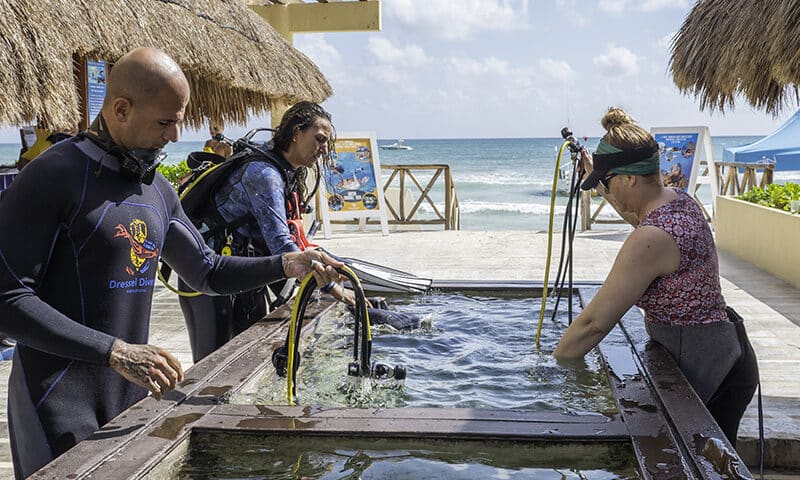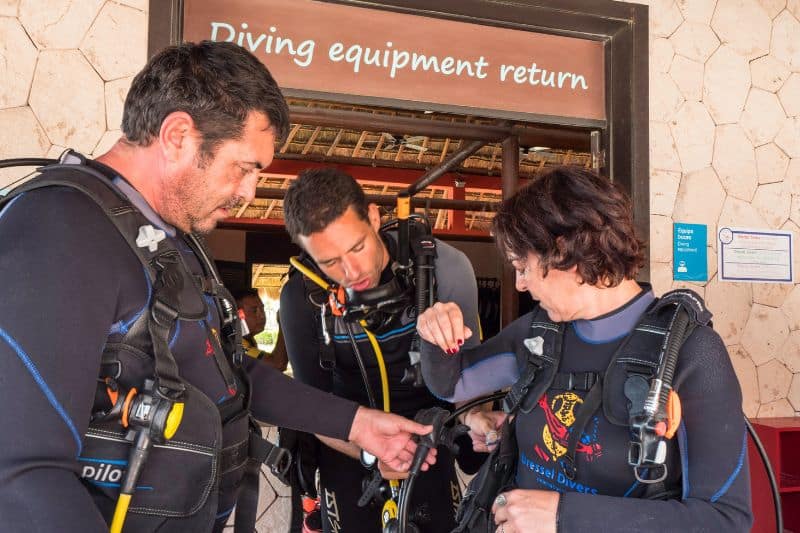2. How Do You Clean Neoprene?
Why Clean Your Wetsuit?
Taking good care of your wetsuit extends its lifespan significantly, and cleaning your wetsuit is a crucial part of that care!
Sweat, salt, and bacteria can accumulate in your suit, degrading the material.
A clean, dry suit prevents corrosion and wear, ready for many more dives!
How to Clean Your Wetsuit Step by Step?
Freshwater Rinse to Clean Wetsuit. After taking off the wet suit, rinse it with fresh water. This removes salt, chlorine, oils, and any dirt that could damage it.
Never use hot water to clean neoprene. It can be fatal for the fibers of your suit! Wash your neoprene with cold water.
Add a specific neoprene cleaner or a mild soap to the water. Forget about chlorine and harsh chemicals! They are enemies of the material.
Scrub gently. Take a soft toothbrush or sponge, dip it in the soapy mixture, and gently scrub the suit, especially the areas with stains or dirt. Be gentle, we don’t want to scratch it!
Rinse, rinse, and rinse. If you only have one container to wash your suit, empty the soapy water and refill it with clean water. Rinse your suit until no cleaner remains.
Drying Instructions Coming Up…
We’ll explain the proper drying process next!
2.1. Neoprene Odor: How Do You Remove Smell?
Just finished your dive and your wetsuit smells…well, let’s just say the ocean isn’t the only biological liquid your wetsuit encountered down there! Don’t worry, this “happens” to the best of us. Here’s how to tackle that “wetsuit smell” and get back to smelling like the fresh sea breeze.
Neoprene Odor Removal:
Several methods can effectively remove that stubborn neoprene odor. Here are a few options:
Vinegar Soak (Neutralizes Outer Odor): Fill a bucket with water and add 1/2 cup of vinegar. Soak your wetsuit for 1 hour, then air dry it. Vinegar helps neutralize the exterior neoprene smell.
Homemade Cleaning Solution (For Strong Odors): Mix 2 tablespoons baking soda, 1 tablespoon white vinegar, and 1 tablespoon black soap in 2 liters of water. Soak your wetsuit for a few hours, then rinse with clean water. Great for tackling strong odors! (Optional) Add a few drops of lavender or tea tree oil to the vinegar solution to mask its smell and add a fresh scent (use sparingly!).
Wetsuit Deodorizer (Proven Effectiveness): Consider using a specialized wetsuit deodorizer. While it might cost a bit more, it’s highly effective at leaving your wetsuit clean and fresh.
Air Drying (Double-Sided): Hang your wetsuit inside out in a well-ventilated area, away from direct sunlight. Once the inside is dry, turn it right-side out to dry the exterior.
Storage (Cool, Dry, and Fresh): Store your wetsuit in a cool, dry place to prevent mold and new odors. To maintain a pleasant smell, place cedar chips or blocks near your stored wetsuit. Cedar has natural deodorizing properties.
We’ve covered the essential steps for cleaning wetsuit. Stay tuned for the next section on proper drying techniques!
2.2. Can You Wash a Wetsuit in a Washing Machine?
No.
Hold On! Ditch the Washing Machine for Wetsuit Washing
After a long dive, you might be tempted to toss your wetsuit in the washing machine for an easy clean. But resist the urge! Big mistake! Here’s why washing wetsuits in a washing machine is a bad idea:
The washing machine is too rough for your neoprene: The spinning and agitation of the washing machine can be too strong for this material. This could stretch it out, tear it, or cause the seams to break.
Your wetsuit would lose some of its adaptability. The hot water in the washing machine could cause the air cells inside the wetsuit to expand, reducing the flexibility of the neoprene, and that’s definitely not cool! Your wetsuit would lose some of its ability to adapt to movement.
It could also do the exact opposite, because the heat weakens the polymer molecular bonds. It can become misshapen and no longer fit you like a glove.
The detergents used in washing machines are a big no-no: They are strong detergents with abrasive chemicals that are forbidden for your neoprene.











